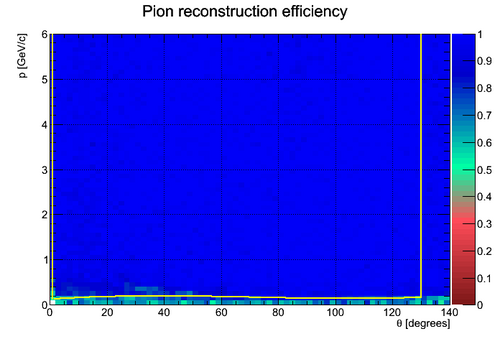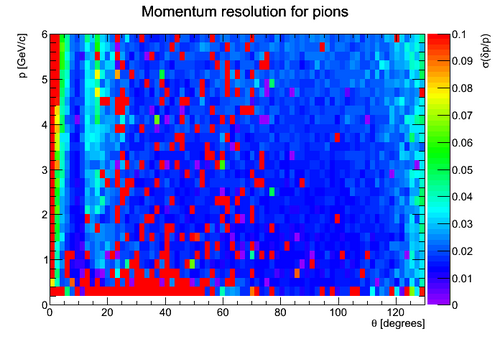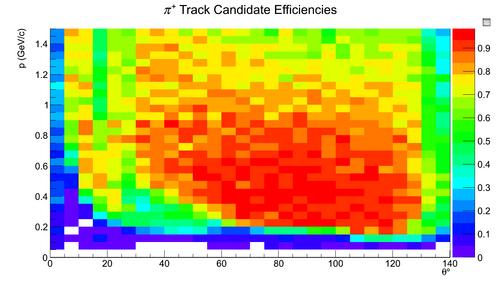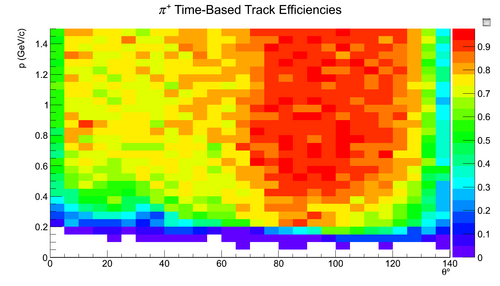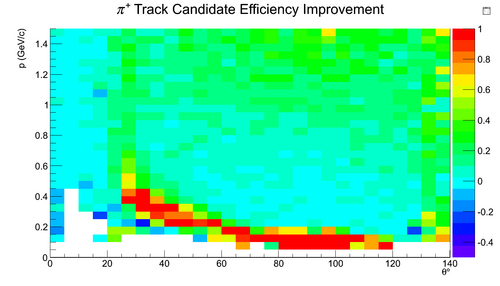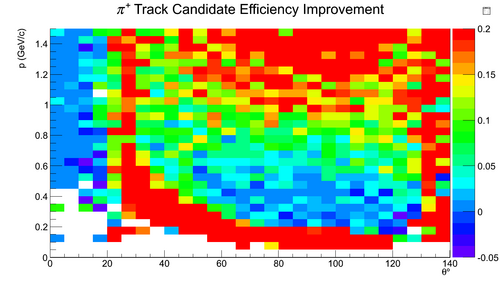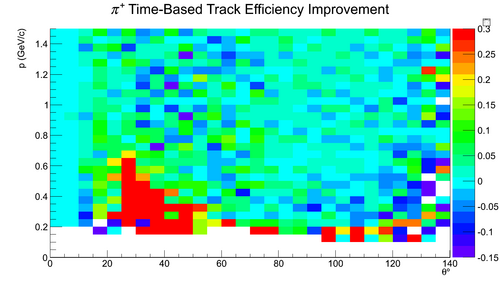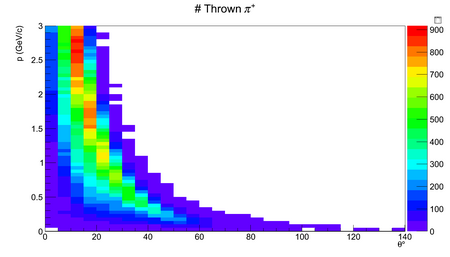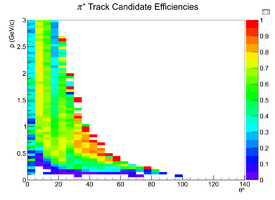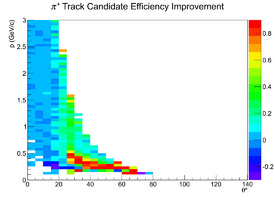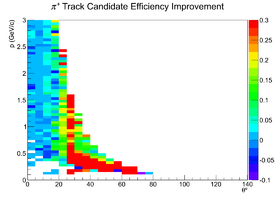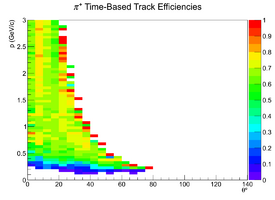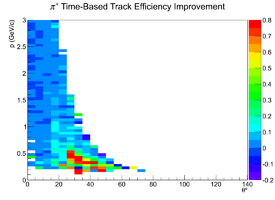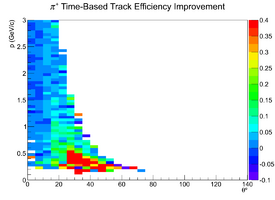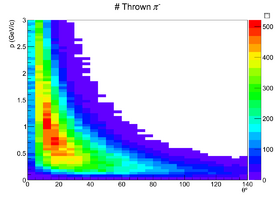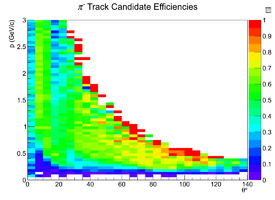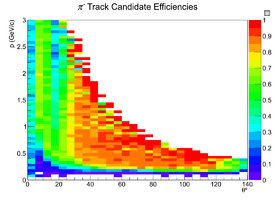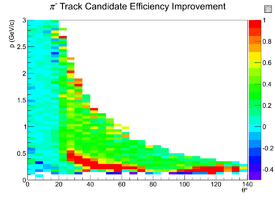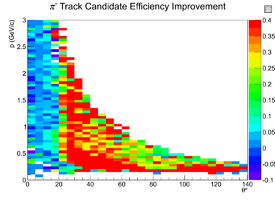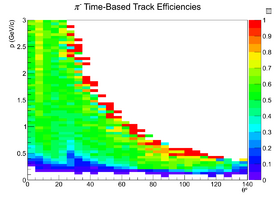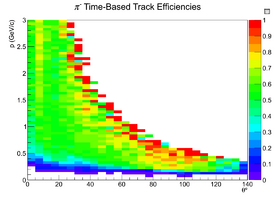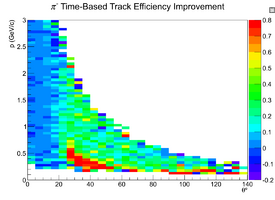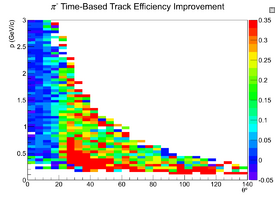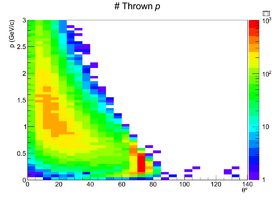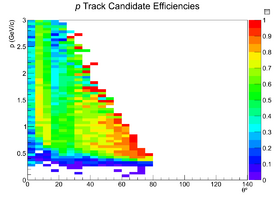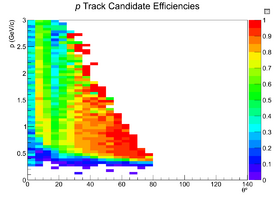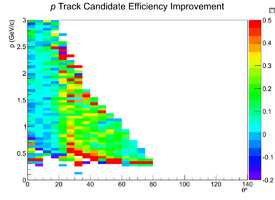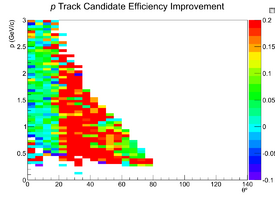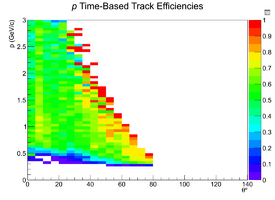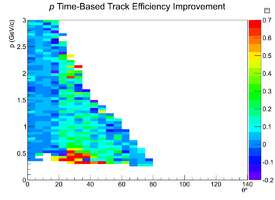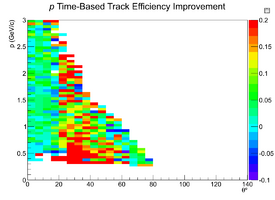Difference between revisions of "Mattione Update 09042013"
From GlueXWiki
(→CDC Track Finding - Overview) |
(→Build Super Layer Seeds) |
||
| Line 10: | Line 10: | ||
** Require a minimum of two hits to form a DCDCSuperLayerSeed (unmatched hits will be added later). | ** Require a minimum of two hits to form a DCDCSuperLayerSeed (unmatched hits will be added later). | ||
* NEW: In each super layer, identify regions with high hit density (> 60% in an area of ~24 straws) and reject all DCDCSuperLayerSeed's passing through those regions. | * NEW: In each super layer, identify regions with high hit density (> 60% in an area of ~24 straws) and reject all DCDCSuperLayerSeed's passing through those regions. | ||
| + | ** This occurs when a spiraling track loops around 6+ times before stopping. | ||
| + | ** This is necessary because in this new code, these events effectively freeze the program with millions of possible combinations of super layer seeds. | ||
* NEW: Identify which DCDCSuperLayerSeed's contain potential spiral turns (where a spiraling track turns back inward/outward) | * NEW: Identify which DCDCSuperLayerSeed's contain potential spiral turns (where a spiraling track turns back inward/outward) | ||
** Primary signature is many adjacent hits in the same ring. | ** Primary signature is many adjacent hits in the same ring. | ||
Revision as of 22:55, 3 September 2013
Contents
CDC Track Finding - Overview
Build Super Layer Seeds
- In each ring, link adjacent hits together (DCDCRingSeed).
- NEW: Do for both axial super layers and stereo super layers (previously just axial).
- In each super layer, link each possible combination of adjacent DCDCRingSeed's together to form super layer seeds (DCDCSuperLayerSeed).
- Note: There may be many combinations. For example, if two tracks cross in an "X" pattern, this will result in four DCDCSuperLayerSeed's.
- NEW: Do for both axial super layers and stereo super layers (previously just axial).
- NEW: Can skip up to 1 ring (in case the track did not deposit enough energy in one of the rings to register a hit).
- Require a minimum of two hits to form a DCDCSuperLayerSeed (unmatched hits will be added later).
- NEW: In each super layer, identify regions with high hit density (> 60% in an area of ~24 straws) and reject all DCDCSuperLayerSeed's passing through those regions.
- This occurs when a spiraling track loops around 6+ times before stopping.
- This is necessary because in this new code, these events effectively freeze the program with millions of possible combinations of super layer seeds.
- NEW: Identify which DCDCSuperLayerSeed's contain potential spiral turns (where a spiraling track turns back inward/outward)
- Primary signature is many adjacent hits in the same ring.
Link Super Layer Seeds
- Link adjacent DCDCSuperLayerSeed's together to form tracks (DCDCTrackCircle).
- Note: Previously, the axial DCDCSuperLayerSeed's were linked by progressively fitting track circles and selecting the next axial super layers that were close to the track fit.
- Note: The projection of the stereo straws onto the X-Y (axial) plane are lines. Therefore, adjacent super layers are determined by checking whether a point (axial) is near a line (stereo), or a line (stereo) is near a line (stereo).
- While the new method results in many more super layer combinations to disentangle, every possible combination is guaranteed to be considered.
- Start in super layer 1 (axial) and expand outwards towards super layer 7 (axial) (was previously in reverse direction)
- Each unique combination of axial super layers, create a new DCDCTrackCircle object.
- Do not attempt seed link if the outer seed is definitely an outward-turning spiral, or if the inner seed is definitely an inward-turning spiral.
CDC Track Finding - Details
Single π+ Track
Single π+ Reconstruction: Current (Trunk) Code, trackeff_hists plugin
- The below plots show the track reconstruction efficiency and resolution for the trunk using the single-track scripts plugin (trackeff_hists).
- However, this efficiency is extremely misleading:
- If a track is reconstructed using any of the hits that were on the thrown track it is considered "found."
- This is regardless of whether the reconstructed track momentum is anywhere close to the thrown values.
Single π+ Reconstruction: Current (Trunk) Code, NEW trackeffv2 plugin
- The below plots show the track candidate and time-based track reconstruction efficiency for the trunk using a new plugin (trackeff_hists).
- This plugin compares matches all of the thrown and reconstructed particles in the event, and requires that their momentum be "close."
- "Close" for track candidates is defined as: Δp/p < 20%, Δθ < 40 degrees, Δφ < 40 degrees, ΔVertex-Z < 1 km
- For thrown tracks with θ < 5 degrees, there is no cut on the candidate Δφ
- "Close" for time-based tracks is defined as: Δp/p < 10%, Δθ < 15 degrees, Δφ < 15 degrees, ΔVertex-Z < 10 cm
- "Close" for track candidates is defined as: Δp/p < 20%, Δθ < 40 degrees, Δφ < 40 degrees, ΔVertex-Z < 1 km
- Note that the degradation of the efficiency at forward angles matches the track resolution plot in the previous section.
- If I expand the requirements for the "Close" window, the efficiency increases, and the chosen parameters were somewhat arbitrary.
Single π+ Reconstruction: NEW Spiral Code
- The below plots show the track candidate and time-based track reconstruction efficiencies for the new spiral code.
- Note: The trackeffv2 plugin compares matches all of the thrown and reconstructed particles in the event, and requires that their momentum be "close."
- "Close" for track candidates is defined as: Δp/p < 20%, Δθ < 40 degrees, Δφ < 40 degrees, ΔVertex-Z < 1 km
- For thrown tracks with θ < 5 degrees, there is no cut on the candidate Δφ
- "Close" for time-based tracks is defined as: Δp/p < 10%, Δθ < 15 degrees, Δφ < 15 degrees, ΔVertex-Z < 10 cm
- "Close" for track candidates is defined as: Δp/p < 20%, Δθ < 40 degrees, Δφ < 40 degrees, ΔVertex-Z < 1 km
- The below plots show the improvements in the track candidate and time-based track reconstruction efficiencies with the new spiral code.
γp→π+π+π-(n)
- The below plots show the track candidate and time-based track reconstruction efficiencies for both track finding codes, and the improvement.
- The definition of closeness is the same as before (see the single-track section).
- Events were generated at beam energy of 9 GeV and a t-slope of 5.0
π+
- Thrown
- Efficiencies
| Stage | Efficiency - Current Code | Efficiency - Spiral Code | Improvement | Improvement - Zoomed |
|---|---|---|---|---|
| Track Candidates | ||||
| Time-Based Tracks |
γp→π+π+π-π-π0(p) (b1pi)
bggen (pythia)
- The below plots show the track candidate and time-based track reconstruction efficiencies for both track finding codes, and the improvement.
- The definition of closeness is the same as before (see the single-track section).
- Events were generated with beam energies between 8.4 and 9 GeV
π-
- Thrown
- Efficiencies
| Stage | Efficiency - Current Code | Efficiency - Spiral Code | Improvement | Improvement - Zoomed |
|---|---|---|---|---|
| Track Candidates | ||||
| Time-Based Tracks |
Proton
- Thrown
- Efficiencies
| Stage | Efficiency - Current Code | Efficiency - Spiral Code | Improvement | Improvement - Zoomed |
|---|---|---|---|---|
| Track Candidates | ||||
| Time-Based Tracks |
